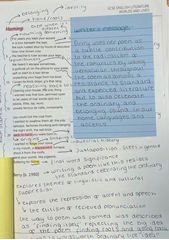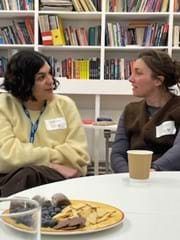On Wednesday 19th May we held an event on Dialogic Learning, chaired by me, with three expert speakers: Professor Neil Mercer, Professor Martin Nystrand and English teacher, Amy Druce. All three have considerable knowledge of dialogic learning, both in principle and in practice. As I said in my introduction to the event, it was taking place in the context of some considerable hostility towards talk in classrooms. High profile educational bloggers have asked why anyone would bother with group work – claiming/suggesting it’s a waste of time. Some have routinely allied talk to poor behaviour and questioned its value on that basis. Direct instruction, teacher as expert, talking from the front, imparting knowledge have all been promoted as the best way of achieving good order in classrooms and, along with that, students’ gaining more knowledge and higher attainment.
Recently, the arguments about dialogic learning bubbled up again on Twitter as a result of our Secretary of State for Education, Gavin Williamson, making a speech about the return to school after lockdown, in which he seemed to be promoting teacher instruction over dialogic approaches.
He said:
the Government will be backing teachers in ensuring children return to a disciplined, safe and orderly environment. We know much more now about what works best: evidence-backed, traditional teacher-led lessons with children seated facing the expert at the front of the class are powerful tools for enabling a structured learning environment where everyone flourishes.
Gavin Williamson, speech, 1st March 2021
The Twitter debate, as it so often does, became quite unpleasant, not the best kind of dialogue. And for me, the most disputatious and undialogic of the tweets were full of false dichotomies and misrepresentations, lacking in depth or context or reference to genuine research, principles or history.
The idea for an event on dialogic learning emerged, where people who know a lot about it, and have dedicated substantial time and thought to it, might come together with teachers to share that expertise.
In what follows, I want to just pull out a few headlines from the speakers’ contributions and the panel discussion and Q&A to highlight some of the important ideas that were raised for me. I think they are worth sharing more widely to contribute to a more informed debate on dialogic learning. At the end, I will include references to some of the key texts that were shared by the speakers and a few more suggestions of my own, for anyone who wants to read the research and hear more of the detail.
Point 1 – It’s not either/or but both
Dialogic learning and instruction are not in opposition to each other, nor do teachers have to choose between them. A balance between classroom dialogue and teacher input is essential. As Amy Druce was keen to point out, though she’s a strong advocate of dialogic learning in her classes, she also instructs and sometimes requires silent work in the classroom. Instruction has to be in the mix, but if there are no ‘dialogic spells’ in classrooms, then students’ learning and attainment suffers. This is borne out by numerous research studies (by Martin Nystrand and others in the 1990s and 2000s and in more recent studies such as The Cambridge Classroom Dialogue Research Project, undertaken by Oracy Cambridge and the EEF Dialogic Teaching Project, led by Robin Alexander).
Point 2 – It doesn’t just happen – it needs to be nurtured
Certain conditions are conducive to good dialogic learning. It can’t just be left to chance. It has to be both taught and nurtured. Neil Mercer talked of a ‘dialogic climate’. Martin Nystrand explored what the conditions are to create ‘dialogic spells’ in classroom. These include some simple and very clear elements: authentic questions, rather than questions that just test bits of knowledge or information; uptake by teachers of the answers to student questions; time devoted to discussion. Neil Mercer described the outcomes of the recent Cambridge Research Project which closely matched Nystrand’s findings, suggesting that three things matter most: high levels of participation by all; children being encouraged to elaborate on their ideas; questioning being encouraged, including both student and teacher questions. The Cambridge research suggested that improvements in student attainment (measured in SATs results) were only achieved if all of these features were seen in combination.
Point 3 – Collaborative learning works if students are taught how to do it
There was a recognition that the group work element of classroom dialogue can be unproductive. It doesn’t always, automatically, work well. You can’t just put students into groups and expect them to be able to argue and debate, unless they are taught how to do it. They need to learn how to talk together well. Talks about talk - meta-talk - can help with that. This was a strong message from both Neil Mercer and Amy Druce. Amy showed examples of her own students reflecting on the quality of their dialogue in impressively thoughtful ways. In the discussion, I raised the question about whether too much meta-talk can risk performance in talk being valued above students being fully absorbed in the topic under discussion – the subject knowledge and understanding that is being developed. That careful balancing of explicit dialogue about what makes talk ‘good’, with a relaxed and unselfconscious focus on the subject of the discussion itself, where students can freely ‘float their notions’ (Bullock), seems to me like an important issue for teachers to consider in promoting good classroom talk.
Point 4 – Questions that lead to more questions are the most fruitful ones
At the heart of good dialogic learning are questions. Martin Nystrand showed transcripts showing the difference between ‘authentic’ questions and ‘test questions’. Authentic questions don’t have single answers. They open up more questions. The opening up of further questions from students, as well as the teacher, is what can spark a sustained dialogic spell in the classroom. ‘Uptake’ is a fundamental aspect of this. It’s what Robin Alexander refers to as the importance of ‘the third turn’, in other words what happens when a question has been asked (the first turn) and an answer has been given (the second turn). In classrooms where there is no third turn, or an unproductive, closed third turn (such as a simple, closing down evaluation like ‘good’, ‘thank you’, ‘that’s right’), dialogue doesn’t take off. The nature of the third turn is critical. It needs to involve ‘uptake’, in other words to probe further, ask for more information or explanation, challenge students’ thinking, reformulate and clarify, and so on. The third turn can spark more turns, from student to student or between students and teachers. It brings students in, as questioners as well as answerers of questions. Nystrand suggested that when the third turn is a question or contribution from a student, this leads to especially successful dialogue.
It seems to me that this simple idea is potentially a game changer for new teachers, or those with little experience of developing classroom dialogue. If you just think about the third turn and what you’re going to do with it then a lot will fall into place.
Nystrand said something very interesting about this, for me, in the panel discussion. He remembered, as a classroom teacher, going home each evening and spending hours planning his next lessons. He began to realise that the best planning he could possibly do was to review the questions he’d asked the day before. Deciding which ones had elicited the most fruitful dialogues would then inform his thinking for the next day. This became a central part of his planning and a way of making sure that the dialogue in the class was really productive.
Point 5 – Dialogue doesn’t prevent teachers from imparting knowledge or giving their view
First, as all the speakers suggested, not everything needs to be dialogic all of the time. Teachers can give their ideas, impart knowledge, talk to the class and, indeed, instruct. In addition, in the skilful orchestration of classroom dialogue they are using their knowledge to challenge and question, adding extra ideas and information in response to the emerging ideas. Martin Nystrand, when asked about where the scope was for the teacher’s view, suggested holding back a bit and offering it towards the end of a discussion, where it wouldn’t inhibit students from voicing their own ideas. I mentioned other approaches, such as presenting one’s own ideas early on but asking students to question, probe and respond to them. I have shared a great example of this in EMC CPD, with two short clips of an online discussion in which Year 7 students entered into debate with their teacher, Lucy Hinchliffe, about her views on a poem. First she offered her knowledge and thinking and then they were put in a position where they could both engage with these and develop their own thinking (and hers!) through talk.
Point 6 – Good dialogue isn’t necessarily about students having equal shares of talk time every lesson
As with so many ideas about teaching and pedagogy, there’s a tendency these days to set fixed rules both for how to do things and how to judge them. So, just as there’s no ‘rule’ that says you can’t do both instruction and dialogue, so we might also question some ideas knocking around about how we judge talk. For me, one of those is the idea that we judge success by whether every student has spoken every lesson, or every student has had equal shares of question and answer. Now obviously, over time, it’s really important for all students to enter into classroom dialogue. As Neil Mercer said, high levels of participation are important. But in a single lesson, perhaps this unrealistic aim gets in the way of really productive dialogue, leading to strings of very short, disconnected contributions rather than a sustained and fully developed chain of thinking for the whole class. In the session, I pointed out the findings of some international research by Robin Alexander (referred to in A Dialogic Teaching Companion) in which marked differences were noted in different countries’ approach to this. Much more sustained dialogue between fewer students and the teacher characterised the dialogic style in France and Russia, as compared with the UK. This led to a very different kind of argumentation and discussion of ideas, where thinking was more elaborated and ideas explored in depth rather than skated over superficially.
Point 7 – A degree of persistence is needed
Both Neil Mercer and Martin Nystrand made the point that developing good dialogic learning involves teachers learning how to do it well. Nystrand was candid in saying that for younger teachers in particular, it poses some challenges. You have to be confident enough in your own knowledge to be able to allow the dialogue to take you in unexpected directions. Handing over some control over what questions are asked to students is both highly fruitful for their learning but also requires more thinking on your feet. One element of the confidence required is also knowing that good dialogue might require a few attempts to get it going. Nystrand quoted this, from one of his research papers:
Starting a discussion is a lot like starting a fire. With enough kindling of the right sort, accompanied by patience, ignition is possible, though perhaps not on the first or second try.
Nystrand, Wu, & Gamoran, Questions in time (2001)
Point 8 – Dialogue really does make a difference to attainment
I’ve already said this, in relation to my first point but I want to re-state it firmly here. For those who are strongly guided by research and try to take it into account when thinking about their own teaching, the research is very clear – not just in small-scale, single classroom-focused studies which look in detail at how learning is happening at a micro-level but also in very large studies over many decades. The work of Martin Nystrand and his colleagues, in the 1990s and 2000s and the recent work of Neil Mercer and colleagues at Cambridge, and Robin Alexander in his EEF study, are all large cohort trials, with control groups, that have proven without doubt the benefits of dialogue as part of the classroom learning environment. Here again, it doesn’t mean that classes with only dialogue had higher attainment but rather that classes with sustained dialogic spells, high levels of student participation, authentic questions and uptake were shown to do better in standardised tests of attainment. Nystrand and colleagues were looking specifically at English (liberal arts in the USA) in high school, so are of particular interest to us as English and Media specialists and their work with very large numbers of schools and students showed conclusively that dialogic activity improves attainment in our subject. The research of Alexander, Mercer and others has drawn similar conclusions from primary schools and across the curriculum.
EMC Event on Dialogic Learning (May 2021) – A Select Reading List
Professor Neil Mercer
CEDIR: Cambridge Educational Dialogue Research: https://www.educ.cam.ac.uk/research/groups/cedir/
Oracy Cambridge: http://oracycambridge.org https://oracycambridge.org/talk-rules/
Thinking Together: https://thinkingtogether.educ.cam.ac.uk/
https://www.educ.cam.ac.uk/research/projects/classroomdialogue/
Mercer, N. & Mannion, J (2018) https://oracycambridge.org/wp-content/uploads/2018/07/Oracy-across-the-Welsh-curriculum-July-2018.pdf
Mercer, N. (2019) Language and the Joint Creation of Knowledge. Abingdon: Routledge.
Mercer, N., Wegerif, R. & Major, L. (2019) The Routledge International Handbook of Research on Dialogic Education.
Mercer, N. & Steve Hodgkinson (2008) Exploring Talk in School: Inspired By The Work Of Douglas Barnes
Professor Martin Nystrand
Nystrand, M. (2006, May). Research on the role of classroom discourse as it affects reading comprehension. Research in the Teaching of English, 40, 392-412.
Applebee, A., Langer, J., Nystrand, M., & Gamoran, A. (2003). Discussion-based approaches to developing understanding: Classroom instruction and student performance in middle and high school English. American Educational Research Journal, 40, 685-730.
Nystrand, M., Gamoran, A., & Carbonaro, W. (1998). Towards an ecology of learning: The case of classroom discourse and its effects on writing in high school English and social studies. Report Series 2.34. Madison: National Research Center on English Learning and Achievement.
Nystrand, M., & Gamoran, A. (1991). Student engagement: When recitation becomes conversation. In H. Waxman and H. Walberg (Eds.), Contemporary Research on Teaching. Berkeley: McCutchan.
Further resources
Alexander, R (2020). A Dialogic Teaching Companion. Routledge)
EEF Dialogic Teaching Project Results https://educationendowmentfoundation.org.uk/projects-and-evaluation/projects/dialogic-teaching/




